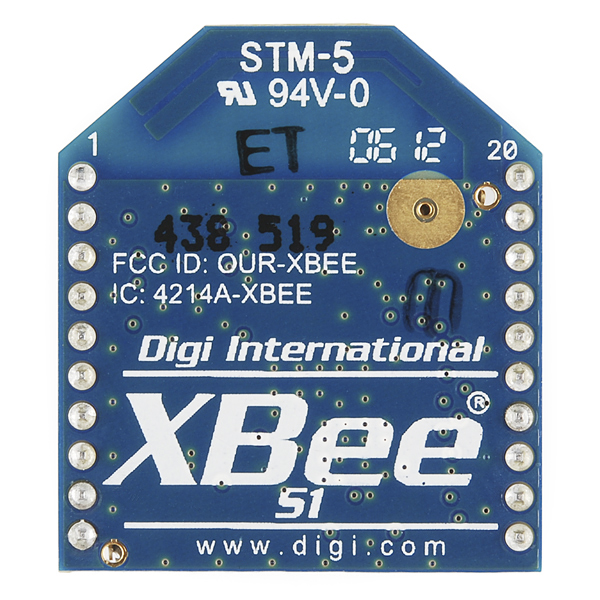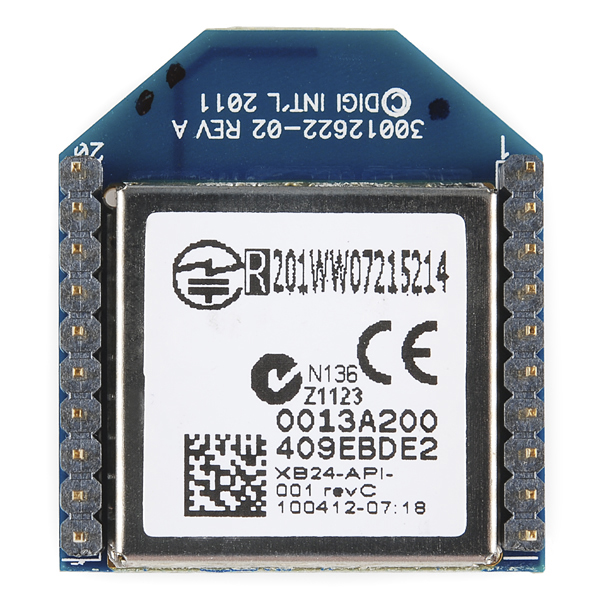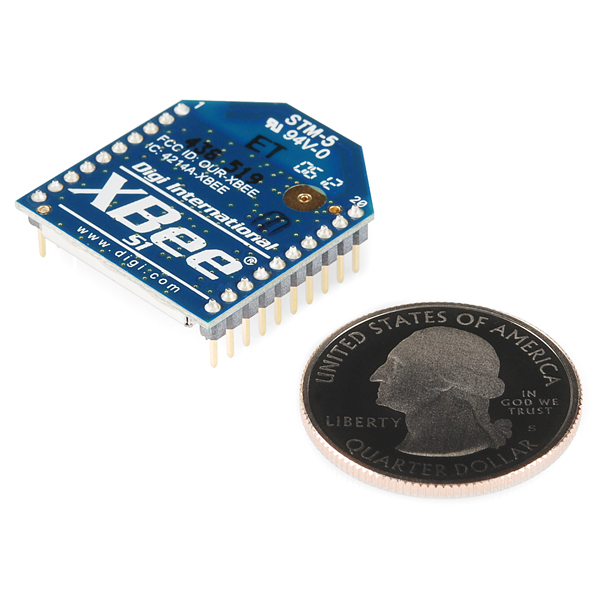XBee 1mW Trace Antenna - Series 1 (802.15.4)
This is the very popular 2.4GHz XBee module from Digi. These modules take the 802.15.4 stack (the basis for Zigbee) and wrap it into a simple to use serial command set. These modules allow very reliable and simple communication between microcontrollers, computers, systems, really anything with a serial port! Point to point and multi-point networks are supported.
Not sure which XBee module or accessory is right for you? Check out our XBee Buying Guide!
Note: If you are using these outside of the United States, please check with your local laws regarding radio communication.
Replaces:WRL-08664
- 3.3V @ 50mA
- 250kbps Max data rate
- 1mW output (+0dBm)
- 300ft (100m) range
- Fully FCC certified
- 6 10-bit ADC input pins
- 8 digital IO pins
- 128-bit encryption
- Local or over-air configuration
- AT or API command set
- Trace Antenna
XBee 1mW Trace Antenna - Series 1 (802.15.4) Product Help and Resources
Wireless Joystick Hookup Guide
January 5, 2017
A hookup guide for the SparkFun Wireless Joystick Kit.
Experiment Guide for RedBot with Shadow Chassis
May 28, 2015
This Experiment Guide offers nine experiments to get you started with the SparkFun RedBot. This guide is designed for those who are familiar with our SparkFun Inventor's Kit and want to take their robotics knowledge to the next level.
Wireless RC Robot with Arduino and XBees
March 12, 2019
In this tutorial, we will expand on the SIK for RedBot to control the robot wirelessly with XBee radios! We'll explore a different microcontroller and wirelessly control the RedBot at a distance.
Teensy XBee Adapter Hookup Guide
June 18, 2015
Getting started with the Teensy 3.1 / Teensy 3.2 and XBee. Establishing a serial link.
Simon Splosion Wireless
February 13, 2014
This is a tutorial demonstrating one of many techniques to "hack" the Simon Says. We will highlight the technique to take your Simon Says Wireless.
Wireless Glove Controller
April 24, 2019
Build a wireless glove controller with Arduinos to trigger an LED using XBees!
Serial Controlled Motor Driver Hookup Guide
November 17, 2016
Hookup guide for the Serial Controlled Motor Driver
Wireless Motor Driver Shield Hookup Guide
August 17, 2017
Get started with the SparkFun Wireless Motor Driver Shield!
XBee Shield Hookup Guide
June 5, 2014
How to get started with an XBee Shield and Explorer. Create a remote-control Arduino!
Wireless Gesture Controlled Robot
April 25, 2019
Control the RedBot wirelessly based on the movement of your hand using an accelerometer, Arduino, and XBees!
Exploring XBees and XCTU
March 12, 2015
How to set up an XBee using your computer, the X-CTU software, and an XBee Explorer interface board.
Core Skill: Programming
If a board needs code or communicates somehow, you're going to need to know how to program or interface with it. The programming skill is all about communication and code.
Skill Level: Rookie - You will need a better fundamental understand of what code is, and how it works. You will be using beginner-level software and development tools like Arduino. You will be dealing directly with code, but numerous examples and libraries are available. Sensors or shields will communicate with serial or TTL.
See all skill levels
Core Skill: Electrical Prototyping
If it requires power, you need to know how much, what all the pins do, and how to hook it up. You may need to reference datasheets, schematics, and know the ins and outs of electronics.
Skill Level: Noob - You don't need to reference a datasheet, but you will need to know basic power requirements.
See all skill levels
Comments
Looking for answers to technical questions?
We welcome your comments and suggestions below. However, if you are looking for solutions to technical questions please see our Technical Assistance page.
Customer Reviews
3.3 out of 5
Based on 4 ratings:
2 of 2 found this helpful:
Good for many to one configuration; but the sparkfun ordering and shipping is not reliable
XBee as product is excellent!!!! There is a learning curve involved to configure Xbee, once you know how to configure you are good. Not very clearly documented on xbee website that VREF is must if you want to use gpio as ADC.
I placed two orders, total of some 10 Xbee modules from spark fun. Their shipping and ordering system is not mission critical. The two day shipping I paid was not shipped on time. I have heard similar stories from many of my friends at work.
seems to work, just not with Arduino
I have been able to get two XBees communicating when both are plugged into a computer running XCTU (one on a USB explorer dongle one on an Arduino running an empty sketch).
However, I have not been able to get the Arduino itself to interact with the module.
It sounds like you needed to upload a serial passthrough code https://learn.sparkfun.com/tutorials/xbee-shield-hookup-guide#example-communication-test with the Arduino in order to get the XBees functional. The Arduino needs commands to know what to do with the XBee. For more information, try checking the documentation or contacting support if you still have issues.
0 of 6 found this helpful:
Total junk
Downloaded the XCTU program and configured two modules using the software and neither would talk... Nothing in the software works. set both PAN ID to the same number, set on to Cooridator and no way to set the second to Router. only have end point. I have three of these useless pieces of crap.
I finally got them to talk hit and miss.. Built a 0x17 Remote AT Command to turn on pin on two other XBEEs and worked when sending the frame through XCTU but send the same frame from an Adrunio it doesn't work. The transmit light lights but no other XBEE acknowledge and nothing. Disconnect from the Ardunio and run the frame on XTCU and it works. I even look at the frames in XTCU that Ardunio is sending and it is EXACT to that I built and sent in XCTU that works.. Too many problems with this system to warrant its use..I plan on saving my money and moving on with things that work...
Hi, I tested some modules in the new XCTU and everything was working well for me. I would recommend checking out some documentation on configuring the Xbees. It may be that you are making a mistake in your settings/configuration.
Easy serial wireless
Two nodes working out of the box as simple as plugging them in. They passed serial data without any additional configuration needed. Before you go playing in settings I'd strongly suggest testing them to see if your setup of other hardware is correct. Once you have them working then start playing with channels and addresses so you know any issues after that is your configuration. I've worked with numerous radio solutions and these by far are one of the easiest to use. The only real downside is the price, but with the ease of use saving time things balance out.





How well do these compare to the chip and wire antennae?
I find that the wire is better than chip. My UK supplier said that this trace is better than chip, I have not noticed any difference.
And what's the difference between Trace and PCB antennae? It seems the same to me....
No RF-way to solder on an antenna where there already is an antenna. Disrupts the impedance. There are XBee's with u.FL connectors so you can plug in a coax going to a variety of antennas.
PCB antenna to me means antenna formed by copper traces on the XBee. That's what's talked about in the WRL-11215. There is/was an XBee with a similar antenna, in the form of a (blue) silicon chip antenna that mounts on the PCB. That kind of chip antenna is widely used in WiFi and Bluetooth. The antenna has poor/negative gain and an irregular radiation pattern. The PCB trace antenna is likely very similar to the chip antenna, but less costly.
The wire antenna, if you have the space, and if the XBee isn't inside a ferrous metal box, is the best choice. If in an aluminum box- you may be surprised as to how RF-transparent aluminum is, vs. steel.
Transparent aluminum? Brings back memories of a Star Trek movie... In my experience, aluminum is a very effective RF shield. It is used in high power radios to isolate one section from another, for instance. However, if you have an enclosure with a cover which is poorly fitted, or one with too few screws to close the cover, it is possible that RF signals will be able to leak in/out.
To check the shielding effects that aluminum has, put a cellphone into a die-cast aluminum enclosure which has no openings, and call the cellphone. You won't see a missed call displayed when you open the box up.
I have a couple of Series 2 Radios, the wire antenna isn't very tolerant to flexing. Mine broke off the boards ages ago and I had to replace them.
So I have one of these that will not stop transmitting garbage data. Did I fry the thing some how? I've reloaded the firmware and still no change :(
Make sure all your transmission rates match up properly. Sounds like there may be a baud rate that doesn't match. Otherwise, try emailing techsupport@sparkfun dot com with your set up and examples of the data you're getting back. They'll be able to assist you further.
If I have one as master sending serial data, how many clients can I have listening at the same time?
As many as you can afford. Seriously though I don't think there is a limit and if there is its at least a few thousand.
Does anyone know how noise/interference immune these modules are? I'm wondering if these 2.4gh modules would work onboard an RC plane operated from a 2.4gh transmitter. The RC plane transmitter is designed to be capable of interference free operation along side other RC transmitters of the same type but I'm not sure if these Xbee modules can also handle that environment. Anyone have any experience with this?
Don't know about an RC transmitter, but I did have a lot of trouble once when I tried to run these next to a wireless router.
I had just updated the firmware on my XBee with the trace antenna while it was on the XBee Adapter Kit and using the Adafruit USB FTDI TTL-232 cable. The green LED was blinking before the update. After the update, the green light went out and now that particular XBee that was on it won't work. I swapped out the XBees and the second one works with both adapters. What the heck happened?
It can only be set to 115200, why do you say the max data rate is 250kbps?
When I use X-CTU, I can my Xbee OK. I want to add a name to my XBee, I can't find where add the name. Any Help??
hello to all does this xbee its the same that the one that have the blue chip antenna on it?, if i have one with the blue antenna could interact with this with trace antenna as well?. or not?
:)
Do I need to buy the "Xbee Explorer" for it, since it is written in the guide "they don't need to be configured"?
I have a question.
I bought the Xbee explorer USB and have a project that works well with Arduino. When I Serial Monitor, Xbee USB explorer automatically opens the Serial COM port lights and lamps Rx and Tx.
When you step into the LABVIEW the door does not open automatically.
Help me please it is urgent!
Thank you!
Philip
I need to monitor three analog signals 0-5v and ship them to an ardunio, Can I do this with series 1 chips>
Would this work with a Polymer Lithium Ion Battery which is 3.7 volts ?
Hi, please i wanna know if i could build a zigbee mesh topology with those XBEE's serie 1 cause i need to set up a wireless sensor netowrks and i have only nodes with this specifiation; (I mean XBee 1mW Trace Antenna - Series 1 (802.15.4) ) ??
I like series 1 radios better than Series 2 for mesh networks. You do however need to flash the radios to the XB24-DM firmware to use these in a mesh network. (Though if you are reading any zigbee only device or need ultra low power end nodes zigbee is the way to go.)
Hey, I bought a couple xbees from you and actually received two different ones...one being this model and one being the model that it replaced. I am trying to set up the XbeeSerialEcho tutorial you have but I can not get it to work. Are the two xbees compatible still?
Somebody know if i can communicate one xbee pro series 1 with one normal xbee 1mw trace antena Series 1 ?
Yes, any Series 1 modules should be able to talk with any other Series 1 module regardless of antenna type or whether they are regular or pro modules.
I would like to buy WRL-08664 but out of stock should buy this instead of it?
is it possible to get the US version to Aus?
any way we can solder on a wire antenna?